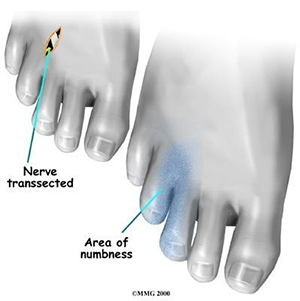- 1300 478 375
Menu
A Morton’s Neuroma is a common foot problem consisting of a benign tumor-like enlargement of a nerve at the ball of the foot. It is usually located between the third and fourth toes, occasionally between the second and third. This condition is not a true tumor but rather a thickening of the tissue around the nerve. Symptoms of a Morton’s Neuroma include sharp pain, burning sensation and even a lack of feeling in the area. It is usually worsened by walking and pressure on the ball of the foot.
Initial therapies are nonsurgical and relatively simple. If conservative treatment does not relieve your symptoms, surgical treatment may be an option. Surgery involves resecting a small portion of the nerve and releasing the tissue around the nerve.

To remove a neuroma surgically, a small incision is made in the skin between the two toes that are affected by the neuroma. The neuroma is located and removed by cutting the nerve. The skin incision is repaired with stitches and a dressing applied.
If you are medically fit, have someone who can collect you and look after you after the operation, and you are comfortable afterwards, the operation can be done on a day case basis. However, if you have other medical problems such as diabetes, asthma or high blood pressure, you may have to be admitted the day before for tests and stay overnight after surgery. If you cannot be collected and looked after you must stay overnight to avoid complications. Most people who have a Morton’s neuroma removed are able to go home the same day.
The operation is usually done under general anaesthetic (asleep). Alternatively, an injection in the back, leg or around the ankle can be done to make the foot numb while the patient remains awake. Your anaesthetist will advise you about the best choice of anaesthetic for you.
In addition, local anaesthetic may be injected into your leg or foot while you are asleep to reduce the pain after the operation even if you go to sleep for the surgery. You will also be given pain-killing tablets as required.
Usually dressings and a bandage will be put on your foot and you can walk on it straight after the surgery. You can put as much weight as comfortable through this, preferably through the heel. Once you are comfortable you are discharged from hospital.
It is very important that the leg remains elevated most of the time in the first 2 weeks – rest is important. Do not wet or remove the dressings.
SWELLING – This can be minimised by elevating your foot above your heart; icing the foot may be helpful
PAIN – You will receive a prescription for pain medication on discharge from hospital. Pain can also be minimised by elevating your leg.
BLEEDING – This always occurs. You may notice some oozing through the bandages.
You will be seen again 10-14 days after surgery for a check on your wound and to advise you on exercises. Once the wound is healing well, you will be encouraged to begin mobilizing on your foot, and exercising your toes to regain movement.
You can walk on the foot straight away. We like you to walk soon as this helps to avoid stiffness. When you are not actually walking, you need to keep your foot up to avoid swelling. Wound healing the critical event in the first 2 weeks.
This depends on what you do and how you get to work. If you have a sitting-down job that you could do with your foot up most of the time, and you can get to work, you could probably go back to work a few days after surgery. On the other hand, if you have a heavy manual job you may be off for up to 6 weeks. If you need to drive to work, this will affect when you can go back. Your surgeon will advise you about going back to work.
You can drive as soon as your foot is comfortable enough and you can wear a suitable shoe. Usually this is 2-4 weeks after surgery. You must be comfortable and not too stiff before trying to drive. Start by sitting in the car and trying the pedals then drive round the block. Drive short distances before long ones. Remember, if you cannot safely make an emergency stop your insurance will not cover you if you have an accident.
As the swelling in your foot goes down and it becomes less stiff, you can start gently exercising your foot and walking further each day. When you are comfortable doing this you can start gentle running and stretching. Contact, twisting and impact sports can follow as comfort dictates. Everyone is different in how quickly they can take up exercise again: be guided by your own body’s reactions and the advice of your surgeon. Most people can get back to most of their previous activities within 3 months.
You may have moderate pain following the surgery and can take panadeine forte as provided or paracetamol The pain should lessen each day.
You should contact Dr Sterling (through the switchboard of the hospital where you had your surgery), or his secretary on 1300 478 375.
Whilst it is unlikely, if you feel extremely unwell, or there is an unexpected delay in finding Dr Sterling, attend the nearest Hospital Emergency Department.




Take the first step towards your treatment and book your initial appointment with our orthopaedic surgery team.
Prefer the phone? 1300 478 375


